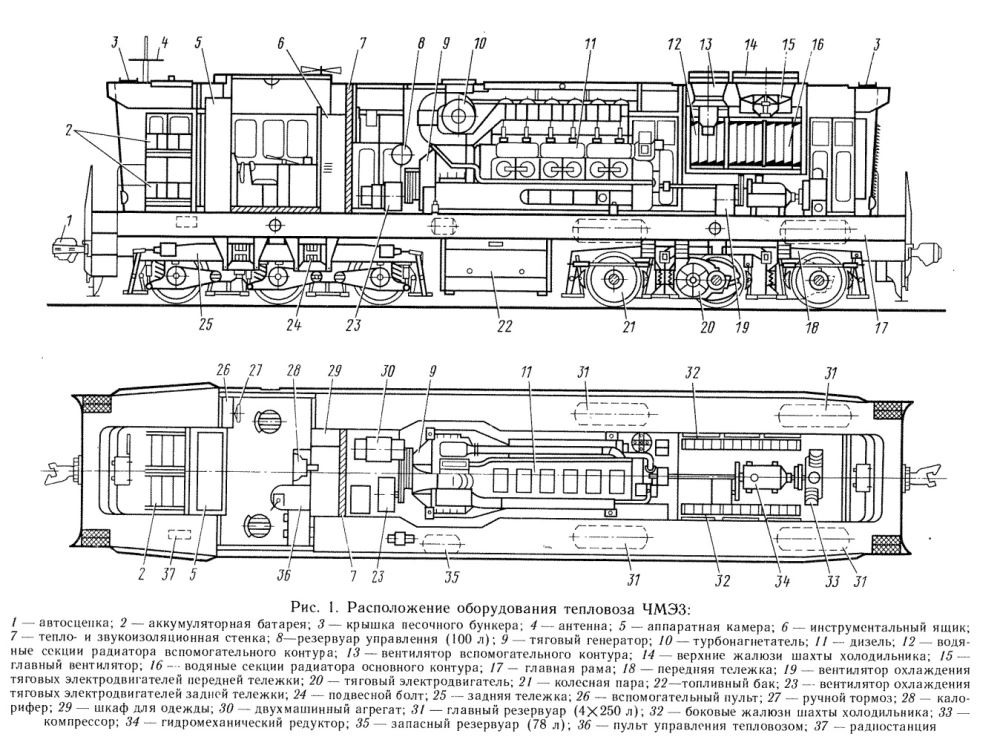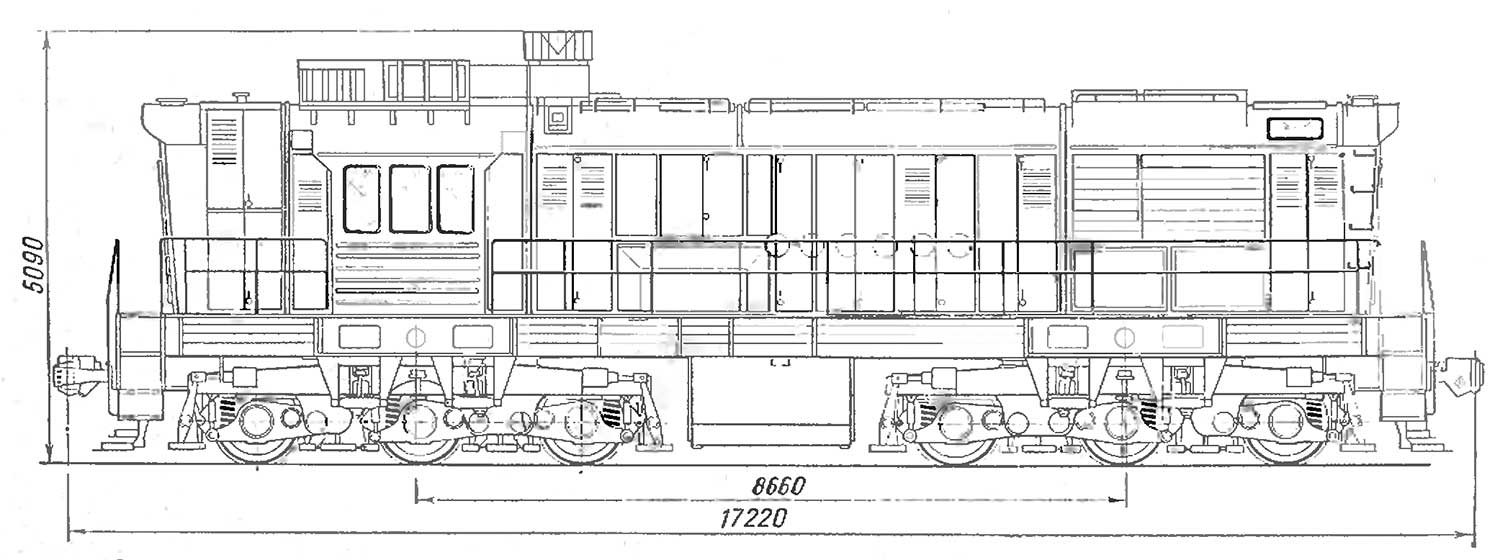ChME3 series locomotives
 The diesel locomotives of the series ChME3 and modifications of the gauge 1520 mm arrived on the railways of the countries of the former USSR, where they became one of the most common series of shunting locomotives. Since the locomotive is made in European size, many diesel engine locators produced for the USSR were used and are being used on a 1,435 mm gauge at the border stations of the former USSR, where European rolling stock goes. The locomotive has two three-axle bogies. Traction motors – with axle support. Thanks to the silent blocks and hydraulic dampers of a diesel locomotive, the course is soft, but if they are not timely serviced, the shock absorbers lose oil, a strong buildup of the machine begins when driving.
The diesel locomotives of the series ChME3 and modifications of the gauge 1520 mm arrived on the railways of the countries of the former USSR, where they became one of the most common series of shunting locomotives. Since the locomotive is made in European size, many diesel engine locators produced for the USSR were used and are being used on a 1,435 mm gauge at the border stations of the former USSR, where European rolling stock goes. The locomotive has two three-axle bogies. Traction motors – with axle support. Thanks to the silent blocks and hydraulic dampers of a diesel locomotive, the course is soft, but if they are not timely serviced, the shock absorbers lose oil, a strong buildup of the machine begins when driving.
Diesel inline six-cylinder displacement of 163 liters, with turbocharging and intermediate cooling charge air. Power at nominal speeds of 750 min − 1 is 1350 hp, the idling speed is 350 min − 1. The piston is made with a combustion chamber, its diameter is 310 mm, the stroke is 360 mm, and the mass is 42 kg. For each cylinder there are four valves of the upper arrangement and one nozzle, the actuator of the valves through roller pushers. There are three pumps on the diesel engine, gear oil and two water pumps, the first one operates mainly on the cooling circuit, the water that washes the cylinder block, and the second in the auxiliary circuit, the water on which cools the oil-water heat exchanger in which the diesel oil is cooled, and the charge air cooler.
Modifications
CHME3M
In order to improve the efficiency of the diesel locomotive ChME3, the designers of the Lokomotivka-Sokolovka plant redesigned it somewhat. Under the new project in 1977, two pilot diesel locomotives CHME3M were built. After testing, they entered trial operation in the depot Lublin. The power of the diesel engine increased to 1,500 horsepower at 775 rpm (the boost was increased from 1.6 atm. To 1.7 atm.), Many changes were made to the electrics, some design parameters were changed (frame length, width of the wheelbase of the carts). The service weight of the locomotive increased from 123 to 126 tons, the fuel stock increased from 5,000 to 6,000 kg. Maximum speed increased from 85 to 100 km / h. Only two CHME3M were made, but the electronic equipment used on them and new constructive solutions of a number of components and parts were later used by the factories in building locomotives CHME3T and CHME5.
CHME3T
In 1984, the plant “Lokomotivka-Sokolovo” built two experimental locomotives CHME3T with resistive (electrodynamic) braking and electronic equipment to realize the maximum power of a diesel engine at a low frequency of rotation of the shaft. The rest of the design is almost identical to CHME3. The mass of the ChME3T locomotive (123 tons), the rated power (1350 hp) and the maximum speed are the same as those of the ChME3 locomotive. The positive results of testing the first copies became the basis for the release in 1985 of an experimental batch of 20 CHME3T diesel locomotives, and then the start of their mass production. A total of 1,167 locomotives of the series ChME3T operate on the railways of the former USSR. Externally, it does not differ from standard FME3, except for the equipment of a rheostatic brake on the roof or a small square elevation on the rear hood (brake resistors exhaust) and intake louvers on the left side of the bonnet (air intake brake resistors), as well as compartments with batteries transferred from the rear hood sides of the fuel tank. Factory locomotive color is slightly different.
CHME3E
Since 1987 began the production of diesel locomotives CHME3E. On CHME3E locomotives, as well as on ChME3T, electronic equipment is installed that ensures the realization of the maximum diesel power at a low shaft rotational speed, which was not on the CHME3 locomotives, but the rheostat brake was not installed. In 1987–1989, the locomotives of the series CHME3E were supplied. In 1987, an experienced ChME3E entered the USSR. In 1988, an experimental batch of 25 locomotives was supplied. In 1989, 220 pieces were delivered. Externally, the locomotive does not have any special differences from CHME3. The factory color of the locomotive is somewhat different.
Upgrades
In 1995–1996, Penzadieselmash specialists together with employees of the Ural branch of VNIIZhT and VNITI developed documentation for modernization, and Michurinsky LRZ installed a new diesel generator 1-PD4V for diesel locomotive CHME3-5188, which received the designation CHME3P (in this case, P “- means with the Penza diesel). In 2010, the diesel locomotive was installed on the territory of the SamGUPS as a museum exhibit, and in March 2013 it was completely written off from the balance of Russian Railways.
The specialists of the Kolomna Plant developed a project to upgrade ChME3 with the installation of a diesel generator of the D49 family and a rheostat brake. The first diesel locomotive to be so modernized was CHME3-1026 of the Northern Railway. He received a series of ChME3K-1026.
In 2008, the Yaroslavl Electric Locomotive Repair Plant carried out modernization of the diesel locomotive CHME3-4342, during which the old diesel engine plant was replaced by two modern production facilities of the Yaroslavl Motor Plant. In this regard, the body hood was upgraded, the driver’s cabin and LED buffer lights were added.
The Czech company ZOS Nymburk has created its own modernization concept. The diesel, the traction generator is actually replaced, the electronics is modernized; hood, carts and cab remain the same. In particular, for this project in 2010, six PME3s were upgraded.
In June 2019, on the ChME3-1562 registry of the Lost depot of the Northern Railway, a software and hardware complex operating according to the vision technology was tested. The complex contains a computing unit, video cameras, a positioning device and other equipment. The developer of the complex is the company Cognitive Technologies. In case of danger (an incorrectly set arrow, a person or another obstacle on the road prohibiting the signal of a traffic light), the system first gives a light signal to the driver. In the absence of the driver’s response to this warning, the system issues a command to brake the onboard system of the locomotive (connection to the electro-pneumatic valve). There is also an automatic control of the speed of the locomotive when coupling with other rolling stock [5].

 Technical details
Technical details
- Axial formula – 30−30
- Diesel power – 1350 l. with.
- TED power – 6 × 134 kW
- Maximum speed – 95 km / h.
- Constructive weight with 2/3 of fuel, water and sand – 123 tons.
- Load from axis to rails – 20.5 t
- Diameter of wheels – 1050 mm
- Gear ratio – 5.06
- The smallest radius of curves – 80 m
- Dimension – 02-T
- Length along automatic coupling axles – 17 220 mm
- Width – 3 120 mm
- Height – 4 637 mm
- Full wheelbase – 12,660 mm
- The distance between the pins – 8 660 mm
- Wheelbase trolleys – 4 000 mm
- Long-haul mode – 23 ts
- Speed of the long mode – 11.4 km / h
- Tangential power – 970 l. with.
- Fuel capacity – 6000 l
- Oil stock – 650 l
- Sand stock – 1500 kg
- Water supply – 1100 l
Copyright © New «Haivoron Diesel Locomotive Repair Plant» PJSC is with you from 2017. All rights reserved